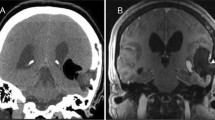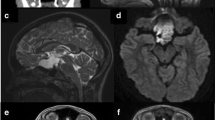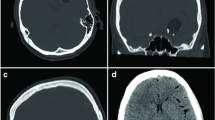Abstract
Background
Intracranial dermoid cysts are uncommon, and their clinical features as well as surgical management differ from patient to patient. Dermoids are generally benign lesions, but may cause spontaneous complications such as meningitis and/or hydrocephalus due to rupture and epileptic seizures depending on their location. Little has been reported about characteristic imaging findings with resulting therapeutic considerations, and only a few reports exist about associated hydrocephalus. Imaging modalities have changed and can facilitate differential diagnosis and follow-up if applied correctly. In this paper, we attempt to contribute our clinical experience with the management of dermoid cysts.
Patients and methods
The charts of five men and two women with intracranial dermoid cysts were retrospectively reviewed. The patients were treated between September 1993 and September 2006. Selected patients are presented in detail.
Results
Tumour location, size and radiographic characteristics varied in each patient. Clinical presentations comprised focal neurological deficits as well as epileptic seizures, persistent headache, mental changes and psycho-organic syndromes. One patient underwent delayed ventriculo-peritoneal shunting after ruptured fatty particles caused obstructive hydrocephalus. Despite dermoid rupture into the subarachnoid space, three patients never developed hydrocephalus. Diffuse vascular supra-tentorial lesions were seen in one patient as a result of aseptic meningitis. Diffusion-weighted imaging (DWI) hyperintensity in dermoids is related to decrease of water proton diffusion and should be used for both the diagnosis and follow-up of this lesion.
Conclusion
Although dermoid cysts are known to be benign entities per se, their rupture can cause a wide range of symptoms including aseptic meningitis and/or hydrocephalus. This may be due to intraventricular obstruction and/or paraventricular compression. While rupture does not necessarily bring about hydrocephalus, radical removal of the tumour and close monitoring of ventricular size is required. Although not widely recognised as such, DWI is considered to be a useful imaging modality in the diagnosis and follow-up of dermoids.







Similar content being viewed by others
References
Ahmad I, Tominaga T, Ogawa A, Yoshimoto T (1992) Ruptured suprasellar dermoid associated with middle cerebral artery aneurysm: case report. Surg Neurol 38:341–346
Akdemir G, Daglioglu E, Ergungor MF (2004) Dermoid lesion of the cavernous sinus: case report and review of the literature. Neurosurg Rev 27:294–298
Aksoy FG, Aksoy OG, Gomori JM (2001) Klippel-Feil syndrome in association with posterior fossa suboccipital dermoid cyst. Eur Radiol 11:142–144
Brown JY, Morokoff AP, Mitchell PJ, Gonzales MF (2001) Unusual imaging appearance of an intracranial dermoid cyst. AJNR Am J Neuroradiol 22:1970–1972
Bucciero A, Del Basso De Caro ML, Carraturo S, Vizioli L, Cerillo A, Tedeschi G (1995) Supratentorial dermoid cysts. Presentation and management of five cases. J Neurosurg Sci 39:7–11
Caldarelli M, Massimi L, Kondageski C, Di Rocco C (2004) Intracranial midline dermoid and epidermoid cysts in children. J Neurosurg Spine 100:473–480
Chen S, Ikawa F, Kurisu K, Arita K, Takaba J, Kanou Y (2001) Quantitative MR evaluation of intracranial epidermoid tumours by fast fluid-attenuated inversion recovery imaging and echo-planar diffusion-weighted imaging. AJNR Am J Neuroradiol 22:1089–1096
Danaila L, Carp N (1989) Dermoid tumour of the fourth ventricle with hyperdense aspect demonstrated on CT scan. Case report. Neurol Psychiatr (Bucur) 27:231–236
Drolshagen LF, Standefer M (1991) Dense dermoid cyst of the posterior fossa. AJNR Am J Neuroradiol 12:317
Dutt SN, Mirza S, Chavda SV, Irving RM (2002) Radiologic differentiation of intracranial epidermoids from arachnoid cysts. Otol Neurotol 23:84–92
Ecker RD, Atkinson JL, Nichols DA (2003) Delayed ischaemic deficit after resection of a large intracranial dermoid: case report and review of the literature. Neurosurgery 52:706–710 discussion 709–710
El-Bahy K, Kotb A, Galal A, El-Hakim A (2006) Ruptured intracranial dermoid cysts. Acta Neurochir (Wien) 148:457–462
Erdem G, Topcu M, Topaloglu H, Bertan V, Arikan U (1994) Dermoid tumour with persistently low CSF glucose and unusual CT and MRI findings. Pediatr Neurol 10:75–77
Ford K, Drayer B, Osborne D, Dubois P (1981) Case report. Transient cerebral ischaemia as a manifestation of ruptured intracranial dermoid cyst. J Comput Assist Tomogr 5:895–897
Gormley WB, Tomecek FJ, Qureshi N, Malik GM (1994) Craniocerebral epidermoid and dermoid tumours: a review of 32 cases. Acta Neurochir (Wien) 128:115–121
Hash CJ, Ritchie DJ (1978) Ruptured intraventricular dermoid cyst without clinical inflammation. Arch Neurol 35:61
Karabulut N, Oguzkurt L (2000) Tetraventricular hydrocephalus due to ruptured intracranial dermoid cyst. Eur Radiol 10:1810–1811
Lunardi P, Missori P (1991) Supratentorial dermoid cysts. J Neurosurg 75:262–266
Lunardi P, Missori P, Gagliardi FM, Fortuna A (1992) Dermoid and epidermoid cysts of the midline in the posterior cranial fossa. Neurosurg Rev 15:171–175
Lunardi P, Missori P, Rizzo A, Gagliardi FM (1989) Chemical meningitis in ruptured intracranial dermoid. Case report and review of the literature. Surg Neurol 32:449–452
Mamata H, Matsumae M, Yanagimachi N, Matsuyama S, Takamiya Y, Tsugane R (1998) Parasellar dermoid tumour with intra-tumoural haemorrhage. Eur Radiol 8:1594–1597
Markus H, Kendall BE (1993) MRI of a dermoid cyst containing hair. Neuroradiology 35:256–257
Martin R, Knone A, Schuknecht B, Kuhn W (1989) Rapid development of occlusion hydrocephalus by intraventricular fat possibly derived from a ruptured dermoid cyst. J Neurol Neurosurg Psychiatry 52:134–135
Messori A, Polonara G, Serio A, Gambelli E, Salvolini U (2002) Expanding experience with spontaneous dermoid rupture in the MRI era: diagnosis and follow-up. Eur J Radiol 43:19–27
Miller NR, Epstein MH (1975) Giant intracranial dermoid cyst: Case report and review of the literature on intracranial dermoids and epidermoids. Can J Neurol Sci 2:127–134
Nakamura M, Mizuguchi M, Momoi MY, Chou H, Masuzawa T (2001) Transient cheiro-oral syndrome due to a ruptured intracranial dermoid cyst. Brain Dev 23:261–263
Neugroschl C, David P, Sadeghi N, Soebert A, Pirotte B, Rorive S, Baleriaux D (2002) Unusual CT features of dermoid cyst in the posterior fossa. Eur Radiol 12:2726–2729
Osborn A (1994) Dermoids. Osborn AG Diagnostic Neuroradiology Mosby, Year Book inc:632–636
Osborn AG, Preece MT (2006) Intracranial cysts: radiologic-pathologic correlation and imaging approach. Radiology 239:650–664
Oursin C, Wetzel SG, Lyrer P, Bachli H, Stock KW (1999) Ruptured intracranial dermoid cyst. J Neurosurg Sci 43:217–220 discussion 220–211
Patkar D, Krishnan A, Patankar T, Prasad S, Shah J, Limdi J (1999) Ruptured intracranial dermoids: magnetic resonance imaging. J Postgrad Med 45:49–52
Phillips WE 2nd, Martinez CR, Cahill DW (1994) Ruptured intracranial dermoid tumour secondary to closed head trauma. Computed tomography and magnetic resonance imaging. J Neuroimaging 4:169–170
Rubin G, Scienza R, Pasqualin A, Rosta L, Da Pian R (1989) Craniocerebral epidermoids and dermoids. A review of 44 cases. Acta Neurochir (Wien) 97:1–16
Sanchez-Mejia RO, Limbo M, Tihan T, Galvez MG, Woodward MV, Gupta N (2006) Intracranial dermoid cyst mimicking haemorrhage. Case report and review of the literature. J Neurosurg 105:311–314
Shinoyama M, Kajiwara K, Harada K, Ideguchi M, Akimura T, Nishizaki T, Suzuki M (2002) [A case of a ruptured dermoid cyst in the sylvian fissure]. No Shinkei Geka 30:1197–1201
Smith AS, Benson JE, Blaser SI, Mizushima A, Tarr RW, Bellon EM (1991) Diagnosis of ruptured intracranial dermoid cyst: value MR over CT. AJNR Am J Neuroradiol 12:175–180
Stendel R, Pietila TA, Lehmann K, Kurth R, Suess O, Brock M (2002) Ruptured intracranial dermoid cysts. Surg Neurol 57:391–398 discussion 398
Stephenson TF, Spitzer RM (1987) MR and CT appearance of ruptured intracranial dermoid tumours. Comput Radiol 11:249–251
Sumida M, Taguchi H, Kuroki K (1999) [A case of recurrent-rupture dermoid cyst]. No Shinkei Geka 27:261–266
Takeuchi H, Kubota T, Kabuto M, Izaki K (1993) Ruptured suprasellar dermoid cyst presenting olfactory delusion (Eigengeruchs erlebnis). Neurosurgery 33:97–99
Tekkok IH, Ayberk G, Kansu T, Saglam S (1989) Bilateral intranuclear ophthalmoplegia associated with fourth ventricular dermoid tumour. J Clin Neuroophthalmol 9:254–257
Venkatesh SK, Phadke RV, Trivedi P, Bannerji D (2002) Asymptomatic spontaneous rupture of suprasellar dermoid cyst: a case report. Neurol India 50:480–483
Wallis SW, Van Roy WJ, Wijnalda D, Van Dijl R (1998) Ruptured intracranial dermoid cyst. J Belge Radiol 81:257
Warakaulle DR, Anslow P (2003) Differential diagnosis of intracranial lesions with high signal on T1 or low signal on T2-weighted MRI. Clin Radiol 58:922–933
Wilms G, Casselman J, Demaerel P, Plets C, De Haene I, Baert AL (1991) CT and MRI of ruptured intracranial dermoids. Neuroradiology 33:149–151
Wilms G, Plets C, Marchal G, Demaerel P (1990) Simultaneous occurrence of epidermoid and dermoid cysts in the posterior fossa: CT and MR findings. AJNR Am J Neuroradiol 11:1257–1258
Yasargil MG, Abernathey CD, Sarioglu AC (1989) Microneurosurgical treatment of intracranial dermoid and epidermoid tumours. Neurosurgery 24:561–567
Author information
Authors and Affiliations
Corresponding author
Additional information
Comment
Orakcioglu et al. submit an interesting report on their experience with intracranial dermoid cysts and give an nice overview on the current literature.
As intracranial dermoid cysts account for less than approx. 0.25% of all intracranial neoplasms, they are up 10 times less common than e.g. intracranial epidermoids. That is why a collection of 7 histologically proven cases seems worth publishing to me. The authors summarize all important information on the different clinical signs and symptoms of ruptured dermoid cysts. They conclude, that long-term follow-up is necessary because of the likelihood of post-op hydrocephalus. I completely support the author’s opinion, that DWI scans are the most useful imaging modality for diagnosis and follow-up exams.
Dr Suess
Charite - Universitatsmedizin Berlin
Rights and permissions
About this article
Cite this article
Orakcioglu, B., Halatsch, ME., Fortunati, M. et al. Intracranial dermoid cysts: variations of radiological and clinical features. Acta Neurochir (Wien) 150, 1227–1234 (2008). https://doi.org/10.1007/s00701-008-0152-x
Received:
Accepted:
Published:
Issue Date:
DOI: https://doi.org/10.1007/s00701-008-0152-x




